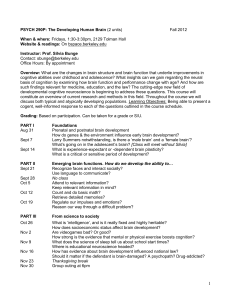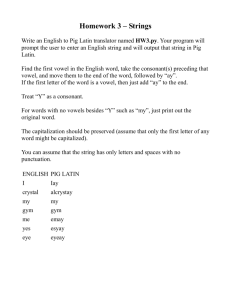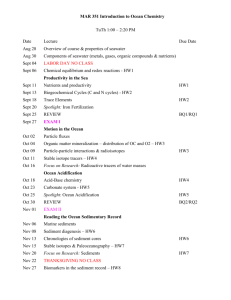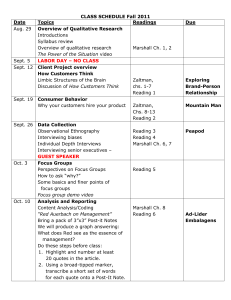Anatomy course syllabus (example)
advertisement
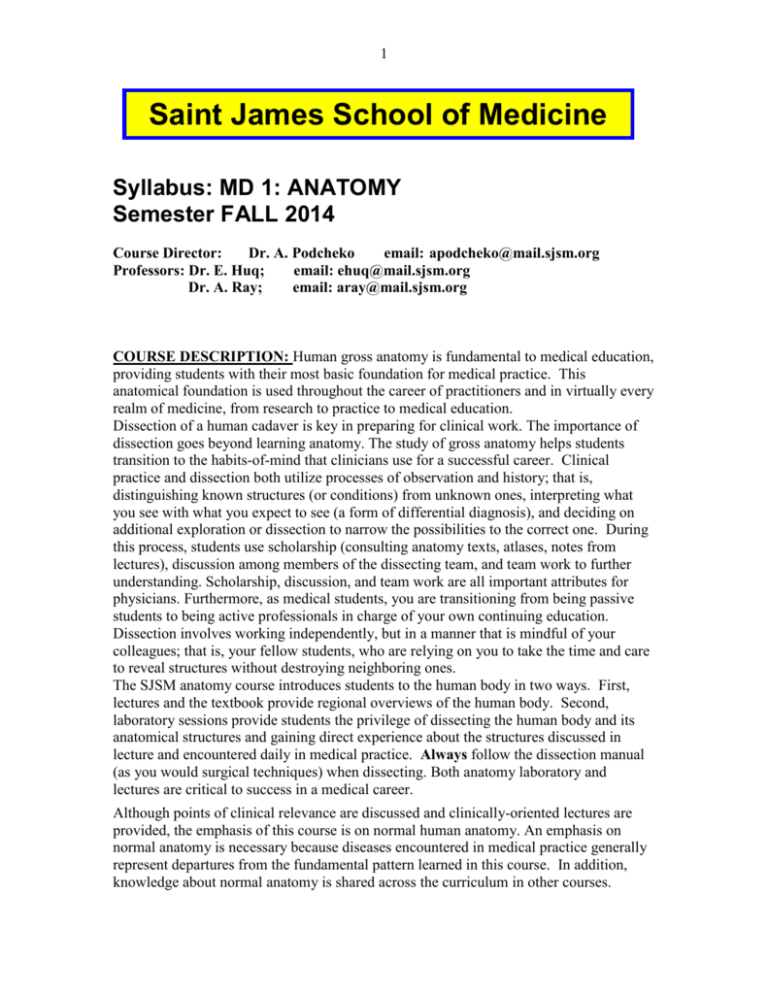
1 Saint James School of Medicine Syllabus: MD 1: ANATOMY Semester FALL 2014 Course Director: Dr. A. Podcheko email: apodcheko@mail.sjsm.org Professors: Dr. E. Huq; email: ehuq@mail.sjsm.org Dr. A. Ray; email: aray@mail.sjsm.org COURSE DESCRIPTION: Human gross anatomy is fundamental to medical education, providing students with their most basic foundation for medical practice. This anatomical foundation is used throughout the career of practitioners and in virtually every realm of medicine, from research to practice to medical education. Dissection of a human cadaver is key in preparing for clinical work. The importance of dissection goes beyond learning anatomy. The study of gross anatomy helps students transition to the habits-of-mind that clinicians use for a successful career. Clinical practice and dissection both utilize processes of observation and history; that is, distinguishing known structures (or conditions) from unknown ones, interpreting what you see with what you expect to see (a form of differential diagnosis), and deciding on additional exploration or dissection to narrow the possibilities to the correct one. During this process, students use scholarship (consulting anatomy texts, atlases, notes from lectures), discussion among members of the dissecting team, and team work to further understanding. Scholarship, discussion, and team work are all important attributes for physicians. Furthermore, as medical students, you are transitioning from being passive students to being active professionals in charge of your own continuing education. Dissection involves working independently, but in a manner that is mindful of your colleagues; that is, your fellow students, who are relying on you to take the time and care to reveal structures without destroying neighboring ones. The SJSM anatomy course introduces students to the human body in two ways. First, lectures and the textbook provide regional overviews of the human body. Second, laboratory sessions provide students the privilege of dissecting the human body and its anatomical structures and gaining direct experience about the structures discussed in lecture and encountered daily in medical practice. Always follow the dissection manual (as you would surgical techniques) when dissecting. Both anatomy laboratory and lectures are critical to success in a medical career. Although points of clinical relevance are discussed and clinically-oriented lectures are provided, the emphasis of this course is on normal human anatomy. An emphasis on normal anatomy is necessary because diseases encountered in medical practice generally represent departures from the fundamental pattern learned in this course. In addition, knowledge about normal anatomy is shared across the curriculum in other courses. 2 Students are responsible for participating in both lecture and laboratory components. Attendance in both components is maintained throughout the semester. DISSECTION: All students will be assigned to a group for dissection. Each student is required to have a dissection manual and an atlas in laboratory. The dissection manual we use is Gray’s Dissection Guide to Human Anatomy; second edition, Morton DA, Peterson KD, and Albertine, KH (eds.); Churchill Livingstone: Elsevier. We require Gray’s Atlas, but many students prefer not to bring their new expensive atlases into the laboratory; therefore, we recommend that students purchase a cheaper, used medical-student-level atlas for use in the laboratory. It does not need to be Gray’s. Students who are not dissecting are expected to use the time studying the skeletal models to learn the bones, ligaments, and muscle attachments. Each student should be able to demonstrate the structures to others. Students gain the most from dissection when they are well prepared for it. Consequently for each laboratory, we require students to hand in a signed sheet of paper on which they have written and/or sketched the appropriate line of incision to be made and the structures that they anticipate uncovering and examining that day. No one who has not handed in that sheet will be admitted to the dissection. As with lectures, no more than 20% of the dissections may be missed. Laboratory coats (they may be purchased from SJSM) and closed-toe sandals/shoes are required for the laboratory. Open-toed sandals do not protect you from falling scalpels or cadaver fluids. Laboratory aprons are also helpful in preserving your clothes. The school provides gloves and masks. ABOUT THE CADAVERS Human cadavers are available for dissection by the generosity of the donors and their families. You are one of a very small group allowed the opportunity to participate in this unique learning experience. The privilege of dissecting a human cadaver should be taken seriously and can be revoked. Do not remove anatomical materials from the lab. Always follow the dissection manual as you would surgical techniques when dissecting. Always treat the cadavers with respect and conduct yourself in the lab in a manner indicating proper respect for the dead. Disrespectful behavioral will not be tolerated. COURSE OBJECTIVES The major objectives are to give medical students an appreciation of both the normal structure of human body, excluding the central nervous system. In accomplishing this goal, it is highly desirable for students to correlate lecture information with laboratory exposure. Lecture information in concert with laboratory exposure to organ and tissue will provide an excellent basis for understanding pathophysiology. In fact, a primary aim of this course is to act as an introduction for future Systems Pathophysiology courses. 3 INTENDED LEARNING OUTCOMES FOR ANATOMY COURSE K2. Knowledge and understanding of the principles of Evidence Based Medicine. K12 Knowledge and understanding of normal structure and function of the body and each of its major organ systems. S7. The ability to perform routine technical dissection procedures specic to the medical speciality. Perform practical exercises that entail accurate observation of biomedical phenomenon and critical analyses of data. S18. The ability to apply Evidence Based Medicine principles to clinical decision making AB5. The ability to seek help, when needed, to deal with academic, personal, or interpersonal problems. TEXTBOOKS: Required: Clinically Oriented Anatomy by Keith L. Moore et al., Lippincott Williams & Wilkins, 2010 Atlas of Human Anatomy, 4th edition by Frank H. Netter. Published by Saunders, 2006 or an equivalent atlas will be acceptable Recommended text: BRS Gross Anatomy, 7th edition by Kyung W. Chung. Published by Lippincott Williams & Wilkins, 2008 Appleton and Lange Review of Anatomy Royce L. Montgomery, Kurt Ogden Gilliland McGraw Hill Professional, 2003 RECOMMENDED LINKS: http://thinkanatomy.com (a portal for anatomical images, dissections etc.) http://www.med.umich.edu/lrc/coursepages/m1/anatomy2010/html/index.html http://www.anatomy.wisc.edu/courses/gross/ (dissections) http://www.wesnorman.com (Georgetown University’s anatomist, Wes Norman, has his own site with images, information and quizzes) AnatomyONE portal Visible Body virtual reality dissection system ATTENDANCE POLICY: Students must attend all lectures, review sessions and dissections on a regular basis. (any one with less than 80% attendance will not be allowed to take exams. Excuses have to be approved by the Promotions Committee in accordance to the policy.) EXAMINATIONS: There will be four block exams in the semester (every 3 to 4 weeks). Each is composed of a written and laboratory portion. Each exam will contribute 25% to the final grade in which 80% is based on the written exam and 20% on the practical exam. Quizzes will add bonus points to the grade. The school grading scale is as follows: 4 90-100% = A 80-89% = B 70-79% = C below 70% = F GRADING Every block (app. 3 weeks of classes) you will be evaluated in the following way: 1. Attendance for lectures and lab classes : if you missed >20% of lectures or labs for first time without providing approved Leave of Absence/doctor/legal note, 20 points will deducted from your final block score (second time you did it – will get 0 for the block). But if you attended >80% of classes - no deduction will be done. 2. 1 written 25 MCQs quiz/block (dates of quizzes are in the syllabus) will provide up to 10 bonus points (*) to final block score 3. 1 written 50 MCQs block exam – will provide 80% of your block score 4. 1 practical exam (identification of specific structures on cadavers, bones, X-Ray films, etc) – will provide 20% of your final score (*) – If student missed block quiz due to medical emergency, legal issues or approved LOA or any other reasons, there will be no second date to take the quiz and student will loose bonus points (but still can get 100% on exam if will do well, see examples below) Example of score calculation for student A: Student A attended 100% of all classes Student A on the quiz answer 60% of questions correctly – received 6 points Student A on the Written exam answer 70% of questions correctly – received 70*0.8=56 points Student A on the Practical exam answer on 80% of questions correctly – received 0.2*80=16 points Final score of the student for Block 1 is : 6+56+16=78 (C) Example for calculation for Student B: Student B attended 100% of all classes Student B on the quiz answer 100% of questions correctly – received 10 points Student B on the Written exam answer 100% of questions correctly – received 1*80=80 points Student B on the Practical exam answer on 100% of questions correctly – received 0.2*100=20 points Final score of the student B for Block 1 is : 10+80+20=110=100 (A) (if calculated score is above 100, then any scores above 100 will not be taken into calculation and will not be transferred to the next block). Cumulative score for whole semester will be calculated as an average of 4 blocks scores. Curving: Curving will be done only for 50 questions MCQ exam in case if average of the group is below 70 and aim of the curving is to bring average score of the group to the range of 70 by using the following formula: Curved Score=100-A(100-You Raw Score) A could be between 0-1. 5 Practical exam: In general, structures tested on the practical exam could be found in the latest version of the document “List of structures for practical exam Block 1,2,3,4”). Students should refer to the latest updated version of structures for particular practical exam posted on the Moodle by professor. Professor can add to the practical exam structures which were not on the list, in such case, the correct answers on the questions related to the structures which are not on the list, will be considered as a bonus points (no more than 20 extra points). Lecture Schedule: Day Tue Date Sept 2 Wed Sept 3 8 to 10 am Thu Sept 4 8 to 10 am Fri Sept 5 8 to 10 am Saturday Sept 6 Sunday Sept 7 Monday Sept 8 Tuesday Sept 9 Wednesda y Thursday Sept 10 Friday Sept 12 Saturday Sept 13 Sunday Monday Sept 14 Sept 15 Tuesday Sept 16 Sept 11 Lecture Lecture topics Orientation Day Instructor No lectures Introduction to anatomy: approach to study anatomy (regional, systemic and clinical anatomy), anatomical terminology, anatomical variation Integumentary system; fascias, fascial compartment, bursae, and potential spaces; skeletal system; muscle tissue and muscular system Cardiovascular system; lymphoid system; nervous system (CNS, PNS, ANS); medical imaging techniques Podcheko 8 to 10 am 8 to 10 am 8 to 10 am 8 to 10 am 8 to 10 am Back; vertebrae and spinal cord Huq Back; muscles, neurovascular structures Back: Review Huq Thoracic wall - Skeleton of thoracic wall, thoracic apertures Thoracic wall – Muscles, nerves and vascular supply Podcheko 8 to 10 am 8 to 10 am Breast Podcheko Thoracic cavity and viscera pleura Podcheko Huq Huq Huq Podcheko 6 8 to 10 am 8 to 10 am 8 to 10 am Lungs Podcheko Pericardium, the heart and great vessels Mediastinum Podcheko 8 to 10 am 8 to 10 am 8 to 10 am Quiz1 Lungs and Heart Lungs and Heart Wednesda y Thursday Sept 17 Friday Sept 19 Saturday Sept 20 Sunday Monday Sept 21 Sept 22 Tuesday Sept 23 Wednesda y Sept 24 Thursday Sept 25 Study Day Friday Saturday Sept 26 Sept 27 EXAM I Sunday Monday Tuesday Sept 28 Sept 29 Sep 30 Wednesda y Thursday Oct1 Friday Oct 3 Saturday Sunday Monday Oct 4 Oct 5 Oct 6 Tuesday Oct 7 Wednesda y Thursday Oct 8 Friday Oct 10 Sept 18 Oct 2 Oct 9 Heart and related structures Ray Ray Ray Ray EXAM I 8 to 10 am 8 to 10 am 8 to 10 am 8 to 10 am Anterior abdominal wall and inguinal region Podcheko Peritoneum, omentum, epiploic spaces, ligaments Abdominal viscera, esophagus, stomach Small intestine Podcheko 8 to 10 am Large intestine, spleen 8 to 10 am 8 to 10 am 8 to 10 am 8 to 10 am Podcheko Podcheko Ray Liver, gall bladder, pancreas Podcheko Retroperitoneum, kidneys, adrenals Posterior abdominal wall, muscles, neurovascular structures Review/Clinical Correlations Podcheko Ray Ray 7 Saturday Oct. 11 Sunday Monday Oct 12 Oct. 13 Tuesday Oct 14 Wednesda y Thursday Oct 15 Friday Oct 17 Saturday Sunday Monday Oct 18 Oct 19 Oct 20 Tuesday Oct 21 Wednesda y Thursday Oct22 Friday Oct 24 Saturday Sunday Monday Oct 25 Oct 26 Oct. 27 Tuesday Oct 28 Wednesda y Thursday Oct 29 Friday Oct 31 Saturday Sunday Monday Nov 1 Nov 2 Nov 3 Oct 16 Oct 23 Oct 30 8 to 10 am 8 to 10 am 8 to 10 am 8 to 10 am 8 to 10 am Pelvis - bony landmarks of pelvis Pelvic peritoneum and fascia 8 to 10 am 8 to 10 am 8 to 10 am 8 to 10 am 8 to 10 am Quiz 2 Urinary system Male sexual organs and female sexual organs Review: Pelvis 8 to 10 am 8 to 10 am 8 to 10 am 8 to 10 am 8 to 10 am 8 to 10 am Podcheko Podcheko Muscles of the pelvis + pelvic diaphragm Pelvis: Neurovascular structures Huq Perineum and triangles: Urogenital + Anal triangles Huq Huq Huq Huq Huq Study Day EXAM II EXAM II Bones and superficial structures of the upper limb Podcheko Pectoral and scapular regions Huq Axilla, brachial plexus Huq Arm and forearm, cubital fossa Huq Hand Huq 8 8 to 10 am 8 to 10 am 8 to 10 am 8 to 10 am Joints of upper extremity Podcheko Joints of the upper extremity Podcheko Review of the upper extremity Podcheko Lower limb: Bones, fascia, vessels & nerves Podcheko Anterior and medial thigh Huq Gluteal region Huq Popliteal fossa Huq Wednesda y Thursday 8 to 10 am Nov 11 8 to 10 am Nov 12 8 to 10 am Nov 13 8 to 10 am Nov 14 8 to 10 am Nov 15 Nov 16 Nov 17 8 to 10 am Nov 18 8 to 10 am Nov 19 8 to 10 am Nov 20 Friday Nov 21 Saturday Sunday Monday Nov 22 Nov 23 Nov 24 Tuesday Nov 25 Wednesda y Nov 26 Thursday Nov 27 Tuesday Nov 4 Wednesda y Thursday Nov 5 Friday Nov 7 Saturday Sunday Monday Nov 8 Nov 9 Nov 10 Tuesday Wednesda y Thursday Friday Saturday Sunday Monday Tuesday Nov 6 Leg - Anterior, lateral, posterior compartments Foot - fascia, muscles, nerves, vessels Quiz3 Joints of lower limb Gait and posture Lower limb: Review Podcheko Podcheko Huq Huq Huq Study Day EXAM III EXAM III 8 to 10 am 8 to 10 am 8 to 10 am Neck; bones and cartilages, fascia Superficial and deep structures Muscles of the neck: anterior and posterior and triangles Vascular structures of the neck and lymphatics Huq Huq Huq 9 Friday Nov 28 Saturday Sunday Monday Nov 29 Nov 30 Dec 1 Tuesday Dec 2 Wednesda y Thursday Dec 4 Friday Dec 5 Saturday Sunday Monday Dec 6 Dec 7 Dec 8 Tuesday Dec 9 Wednesda y Thursday Dec 10 Friday Dec 12 Saturday Sunday Monday Dec 13 Dec 14 Dec 15 Tuesday Dec 16 Wednesda y Thursday Dec 17 Dec 11 Dec 18 8 to 10 am Visceral structures of the neck: trachea, esophagus Podcheko 8 to 10 am 8 to 10 am 8 to 10 am 8 to 10 am 8 to 10 am Viscera cont’d.: Thyroid and parathyroid glands Viscera cont’d.: Larynx Podcheko 8 to 10 am 8 to 10 am 8 to 10 am 8 to 10 am 8 to 10 am Quiz4 Cranium - cont’d Muscles of facial expression and mastication Sensory organs; eye and ear Neural structures of the neck and ansa cervicalis Surface anatomy of the neck and clinical correlations; Review Bones of the cranium; scalp, meninges Nasal cavity; Taste and olfaction Pharynx Oral cavity; Salivary glands LAB Practical EXAM IV EXAM IV Huq Huq Podcheko Ray Ray Podcheko Podcheko Podcheko Podcheko 10 PRACTICAL SCHEDULE: (B: Block, S: Session) Fall 2014 Week 1 Session B1S1 B1S2 B1S3 2 B1S4 B1S5 3 B1S6 S7 AB5 S7 AB5 S7 AB5 S7 AB5 S7 AB5 B2S5 Midgut and Hindgut, Posterior Abdominal Wall Osetology of the Upper Limb, Superficial structures of the upper limb, Shoulder and Axilla Arm, Forearm, B2S6 Hand, Joints of Upper Limb S7 AB5 B2 Review of Abdomen S7 AB5 B2S8 Review of Upper Limb S7 AB5 B3S1 Oseteology of Pelvis, Gluteal Region , Ischioanal Fossa, Urogenital Triangle Pelvis and Reproductive System Male Pelvis and Reproductive S7 AB5 B2S2 B2S3 7 S7 AB5 S7 AB5 4 6 ILOs S7 AB5 Osteology of the abdomen, Pelvis and Perineum, Anterior Abdominal wall, Inguinal Canal, Peritoneum and Foregut , B2S1 5 Dissection Introduction , Lab Safety, Dissection set, Anatomical Position, Planes, Terms of Relationship and comparison, Terms of Laterality and Movement Osteology of the Back, Superficial Back Deep Back, Vertebral Column, Spinal Cord Osteology of the Thorax, Anterior Chest wall, Breast Thoracic Situs, Lungs, Hearts, Mediastina Review of Block 1 B2S4 8 B3S2 B3S3 S7 AB5 S7 AB5 S7 AB5 S7 AB5 S7 AB5 Instructor Professor Dr. Huq, Dr. , Dr. Podcheko Dr. Huq, Dr. , Dr. Podcheko Dr. Huq, Dr. , Dr. Podcheko Dr. Huq, Dr. , Dr. Podcheko Dr. Huq, Dr. , Dr. Podcheko Dr. Huq, Dr. , Dr. Podcheko Dr. HUQ, DR. , DR. PODCHEKO Dr. HUQ, DR. , DR. PODCHEKO Dr. HUQ, DR. , DR. PODCHEKO Dr. HUQ, DR. , DR. PODCHEKO Dr. HUQ, DR. , DR. PODCHEKO Dr. HUQ, DR. , DR. PODCHEKO Dr. HUQ, DR. , DR. PODCHEKO Dr. HUQ, DR. , DR. PODCHEKO Dr. Huq, Dr. , Dr. Podcheko Dr. Huq, Dr. , Dr. Podcheko Dr. Huq, Dr. , Dr. 11 B3S5 System female Osteology of Lower Limb, Superficial Structure of the Lower Limb and Gluteal Region Thigh B3S6 Leg S7 AB5 B3 S7 AB5 B4S1 Foot , Joints of the Lower Limb Review Pelvis and Lower Limb Osteology of Head and Neck B4S2 Triangles of the Neck S7 AB5 B4S3 Larynx S7 AB5 B4S4 S7 AB5 B4 Scalp, Calvarium, Meninges, Brain, Base of the Skull and Cranial Nerves Orbit, Superficial Face, Deep Face, Pharynx Nasal Cavity, Palate, Oral Cavity Ear B4S8 Review Head & Neck S7 AB5 9 B3S4 10 11 12 13 B3S8 B4S5 14 15 B4S6 S7 AB5 S7 AB5 S7 AB5 S7 AB5 S7 AB5 S7 AB5 S7 AB5 Podcheko Dr. Huq, Dr. , Dr. Podcheko Dr. Huq, Dr. , Dr. Podcheko Dr. Huq, Dr. , Dr. Podcheko Dr. Huq, Dr. , Dr. Podcheko Dr. Huq, Dr. , Dr. Podcheko Dr. HUQ, DR. , DR. PODCHEKO Dr. HUQ, DR. , DR. PODCHEKO Dr. HUQ, DR. , DR. PODCHEKO Dr. HUQ, DR. , DR. PODCHEKO Dr. HUQ, DR. , DR. PODCHEKO Dr. HUQ, DR. , DR. PODCHEKO Dr. HUQ, DR. , DR. PODCHEKO Dr. HUQ, DR. , DR. PODCHEKO


